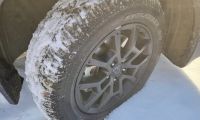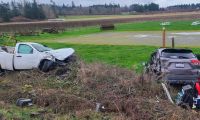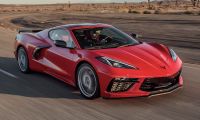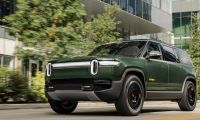Next-Level Driving From Tesla FSD Version 12
In a video released by Tesla Owners Silicon Valley, they show their Tesla driving along the streets of California, stating that:
FSD Beta drives are getting boring because I'm having perfect drives. More and more drives are having zero disengagements.
This is the first software architecture for FSD that uses only neural nets and machine learning to run the code. That means it is largely an issue of providing video training and data labeling in order to get FSD to be ready for autonomy.
Elon Musk responded to their video, saying: "Version 12 is next-level."
However, it's important to note that Elon Musk has often been too optimistic on FSD's progress and the date robotaxis will arrive. He has also stated that even if he is late in the prediction, he is generally correct about it happening.
The biggest question about FSD is now, when will it be ready to have a driverless experience?
Bizarre Reason Caused Tesla Ship Carrying 6,000 Vehicles To Be Turned Back From Australian Port Last Quarterhttps://t.co/a7gwuQ3LfQ$TSLA @Tesla @torquenewsauto #deliveries #vehicles #port #shipping #australia #shanghai
— Jeremy Noel Johnson (@AGuyOnlineHere) January 2, 2024
Another FSD version 12 beta user, Tony Tong, received the over-the-air update while his family was vacationing at Universal Studio in LA.
Tony states that he couldn't wait to get home and upgrade to FSD. He saw that the released notes for version 12 were simple and included:
Version 12 has single-stack end-to-end neural nets trained with millions of video clips for the driving controls. This replaces the previous 300k lines of C++ imperative programming.
You May Also Be Interested In: These Tesla Vehicles Get an Instant $7,500 Rebate Off the Purchase Price: There Are Two That Don't
Thoughts on FSD Version 12 Shared
Tony went on to share his thoughts about his experience with FSD version 12 and broke it down like so:
Positive Surprises
He says the car drives more like a human, and his wife could not tell whether it was him or the vehicle driving.
Highway Situations:
FSD v11 (single-stack highway and locals) already handled highway driving quite well, but you could still sense the mechanistic nature of the C++ code in the control decisions. FSD v12 feels so natural.
Here's one scenario that really surprised me: You're driving in the fast lane (left) of a two-lane highway because slower cars stay in the right lane. Then a faster car approaches from behind. FSD v12 signals, safely switches to the slower lane, lets the faster car pass, then switches back into the fast lane and stays there.
Speed control is much smoother and appears to adjust itself smoothly with the surrounding traffic flow.
FSD v12 is more patient and assertive during lane-changing maneuvers. There's no more "middle-of-the-change hesitation" (changing mind in the middle of a lane change).
City Streets Driving:
One of the "hardest" problems that FSD v11 and earlier versions failed to solve in my nearly three years of testing FSD beta is a surprisingly simple setup – what I call "neighborhood laneless road snaking". It's very common in neighborhoods, where there are single-lane roads wide enough to accommodate roadside parking, or simply single lanes that gradually diverge into more lanes, or vice versa.
Advertising All previous FSD versions struggled and tended to snake left and right within what the car perceived as a "wide" lane. Because of this single defect, I could never convince my wife to trust FSD driving. Well, that's finally gone in v12 with the end-to-end neural networks for driving controls – it simply learns how a good human driver would handle such a situation – just stays the course.
v12's handling of bumps is excellent! It reduces speed very smoothly to about 10 mph while going across bumps, making the ride super smooth.
Tesla Employee Confirms That Optimus Humanoid Robot Will Join the Tesla Assembly Linehttps://t.co/tPR1xKA0NQ$TSLA @Tesla @torquenewsauto #teslabot #humanoidrobot #manufacturing
— Jeremy Noel Johnson (@AGuyOnlineHere) January 1, 2024
Areas For Improvement
STOP signs:
The car really doesn't have to wait a full 5 seconds (I know it's less than that, but it definitely feels that way) at every STOP sign. Every time, I have to push the accelerator to make it go a bit faster. Even if I had the patience, I'm sure the driver behind me wouldn't – they'd be thinking, "What the hell, you're driving a Tesla?!"
Speed Control:
Perfect speed control is challenging because some speed signs are simply incorrect. You can't have a 40 MPH speed limit right in the middle of a highway, or try to accelerate to 70 MPH during a ramp onto the highway. It's definitely better in v12, but this still remains the main input I have to adjust from time to time.
Road Conditions:
Road conditions can sometimes be dangerous. There may be potholes, foreign objects that a good driver would constantly stay alert for and safely maneuver around with fine steering adjustments. I haven't tested FSD v12 enough in such situations, but I believe it will need continuous training to accommodate all these hazardous road situations and learn how to safely handle them.
Weather:
As stated by Tesla, it is now mainly trained for good weather conditions (such as in California), and still needs a lot more training in areas with heavy precipitation, including rain and snow.
Final Conclusion
FSD v12 with single-stack neural networks for driving controls is definitely the (ONLY) right path forward. In fact, I think Tesla should have taken this approach much earlier rather than wasting time and effort tuning the C++ code for driving controls, which would have made it practically impossible to realize true FSD.
Now with FSD v12, I see a step change that fundamentally solves those "hard-to-solve" issues – just mimic humans! The rest is just more data and more training. That's it!
My Thoughts
I think this is a pretty good recap of FSD. It's unknown to me if Tony is an employee of Tesla or not, because my understanding is that only Tesla employees are getting FSD Version 12. However, there may be some special cases granted, and Tony might be one of those.
I am in agreement that removing 300,000 lines of C++ code is only going to accelerate FSD and make it better faster. I think that we'll see a robotaxi ride by the end of the year, even if it is just in a Boring Tunnel in Las Vegas.
In Other Tesla News: Tesla Employee Confirms That Optimus Humanoid Robot Will Join the Tesla Assembly Line
What do you think about Tesla FSD Version 12 using only neural nets? Is this going to accelerate driverless Tesla vehicles?
Share this article with friends and family and on social media - or leave a comment below. You can view my most recent articles here for further reading. I am also on X/Twitter where I post more than just articles daily, as well as LinkedIn! Thank you so much for your support!
Hi! I'm Jeremy Noel Johnson, and I am a Tesla investor and supporter and own a 2022 Model 3 RWD EV and I don't have range anxiety :). I enjoy bringing you breaking Tesla news as well as anything about Tesla or other EV companies I can find, like Aptera. Other interests of mine are AI, Tesla Energy and the Tesla Bot! You can follow me on X.COM or LinkedIn to stay in touch and follow my Tesla and EV news coverage.
Image Credit & Article Reference: Tony Tong (GoProAI) | Tesla Owners Silicon Valley via Elon Musk











